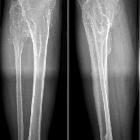hereditary multiple exostoses






































Hereditary multiple exostoses, also known as diaphyseal aclasis or osteochondromatosis is an autosomal dominant condition, characterized by the development of multiple osteochondromas.
Epidemiology
Hereditary multiple exostoses demonstrate an autosomal dominant inheritance pattern, with incomplete penetrance in females. The number of exostoses, the degree, and type of angular deformity, and even the rate of malignant transformation varies significantly, even within families.
Clinical presentation
Most patients are diagnosed by the age of 5 years, and virtually all are diagnosed by the age of 12 years. Patients may be asymptomatic with a few small lesions or may be significantly deformed by multiple large osteochondromas.
Radiographic features
Except that they are multiple, imaging features are identical to solitary osteochondromas. The skeletal distribution of lesions can significantly vary, with some authors noting that the typical distribution is bilateral and symmetric, whereas others report a strong unilateral predominance.
Often associated with a broadened shaft at the end of long bones, hence the term diaphyseal aclasis.
Complications
Are also similar or those of solitary osteochondroma and include:
- vascular impingement
- neural impingement
- fracture
- bursitis
- deformity and ankylosis
- malignant transformation
Malignant transformation is more common than in sporadic cases, with transformation rates reported as high as 25% (lower rates of 3-5% have also been published) . The mnemonic GLAD PAST lists the associations with sarcomatous transformation.
Refer to the generic osteochondroma article for more information.
See also
Siehe auch:
- Exostose
- kartilaginäre Exostose
- Foramina parietalia permagna
- Impingement Syndrome bei Patienten mit multiplen kartilaginären Exostosen
und weiter:
- Chondrosarkom
- Dysplasia epiphysealis hemimelica
- Exostose des Femur
- radiologisches muskuloskelettales Curriculum
- Knochentumoren
- Foramen parietale
- Madelung-Deformität
- premature closure of a growth plate
- Chondromatose
- Verkürzung Metakarpale vier oder fünf
- Metachondromatose
- Osteochondromatose
- buccale Exostosen
- Kartilaginäre Exostosen bei Kindern
- kartilaginäre Exostosen Becken
- Femurexostose
- Exostosen Kniegelenk

 Assoziationen und Differentialdiagnosen zu Multiple kartilaginäre Exostosen:
Assoziationen und Differentialdiagnosen zu Multiple kartilaginäre Exostosen:




